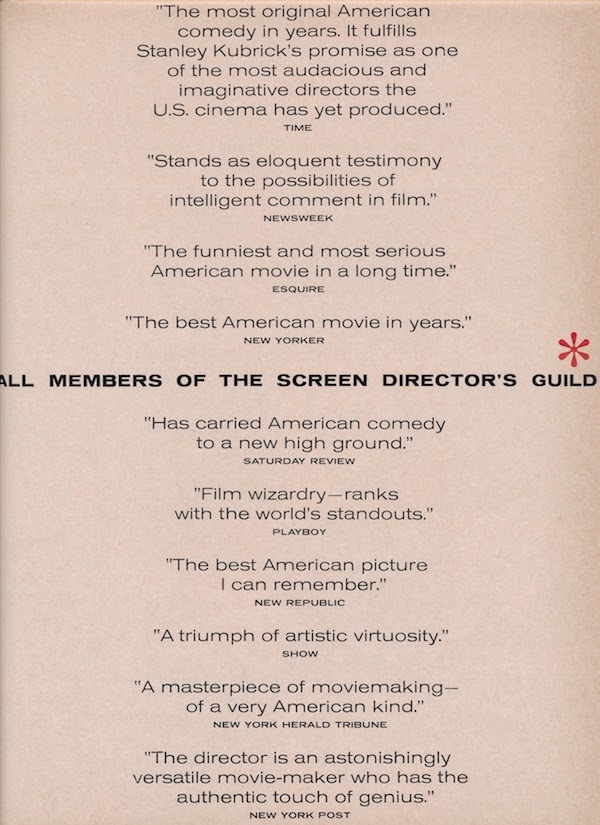Reflecting on the way that Japanese bomb film Ikimono no Kiroku portrayed the bomb raises the question of whether Kurosawa successfully challenged social denial about the bomb. Even though there are far more such weapons today and they are much more destructive than those of the 1950s, perhaps we are still in denial. Is there any fear and anxiety about this problem today, or have we, as Kubrick suggests, 'learned how to stop worrying and love the bomb?’ Like Kurosawa, although from a completely different, more irreverent, even sardonic viewpoint, Dr Strangelove also looks at the theme of sanity and insanity related to the bomb. Kubrick focuses on a psychotic general who launches a nuclear strike on the Soviet Union to protect his ‘precious bodily fluids.’ By looking at a two of the promotional materials for Dr Strangelove, we can see that the focus began to drift away from the message and more toward cinematic elements.
This drift is evident in the announcement at the left, which was published in The Hollywood Reporter, on Monday 21 December 1964, inviting members of the Screen Directors Guild to attend screenings of Dr. Strangelove. The Screen Directors Guild, now known as the Director's Guild of America, is an influential trade union that represents the interests of American film and TV directors. Note the reviews regaling the film as a major achievement in American cinema at the time and as an 'audacious' comedy and an 'intelligent comment.'
Like many films, Dr. Stranglove was promoted internationally and not only in the year of its initial release. A revival campaign for the film in Spain used the poster below. A date on the bottom right reads 2001, although that might be the name of the distribution company. The source for this poster traced it to a 1980 revival of the film. Either way, it isn't for the original release, which in Spain was January 1966. Instead of 'How I learned to stop worrying and love the bomb,' for the Spanish revival promotional materials the secondary title has been changed to 'Telefono rojo, volamos hacia Moscu,' which translates as 'Red telephone? We're flying to Moscow!' (other Spanish materials omit or vary the punctuation).
Above that, at the upper left, it says, 'While military blocs have fun with their arms race, humanity hangs in the balance,' retaining some of the satirical flavour of the American title but also the warning of Ikimono. The rest of the text on the Spanish poster is more or less similar to the English promotional materials. The photo is an interesting choice, it shows Major Kong in the bomb bay of the mock B-52, in a scene from the latter part of the film. Notice the graffiti on the bombs, 'Hi there!' and 'Dear John.' It seems to have been common practice in wars for British and American military to write cute slogans on their bombs, which is also evident in more recent wars. Also stencilled on the bomb is the ironic, satirical warning, 'Nuclear warhead. Handle with care.' Who knows if real bombs had these words on them, but in general the attention to detail in this shot is astounding: these of course are not real bombs, but it demonstrates the care with which the production designers created the B-52 bomber set.
[This essay by J. Progler continues from the previous post, and is part of a series of reflections on the promotional materials for atomic bomb films that he has used in teaching about the bomb in film at Ritsumeikan Asia Pacific University.]


No comments:
Post a Comment